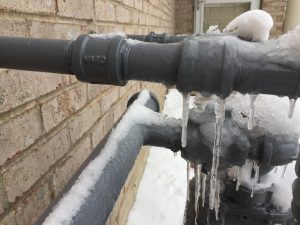Ways to Protect Pipes from Freezing Damage: Important Guidance
Ways to Protect Pipes from Freezing Damage: Important Guidance
Blog Article
The article author is making a number of good points on the subject of 6 Ways to Prevent Frozen Pipes overall in the content following next.

Winter can damage your plumbing, especially by freezing pipes. Below's exactly how to prevent it from occurring and what to do if it does.
Intro
As temperatures drop, the threat of frozen pipes increases, potentially bring about pricey repair work and water damages. Comprehending just how to prevent icy pipelines is essential for home owners in cool climates.
Avoidance Tips
Shielding susceptible pipelines
Cover pipes in insulation sleeves or use heat tape to safeguard them from freezing temperatures. Concentrate on pipes in unheated or exterior areas of the home.
Home heating techniques
Keep indoor rooms adequately warmed, specifically areas with pipes. Open up closet doors to permit cozy air to distribute around pipelines under sinks.
Exactly how to identify frozen pipelines
Try to find decreased water flow from taps, uncommon odors or noises from pipelines, and noticeable frost on exposed pipes.
Long-Term Solutions
Architectural changes
Consider rerouting pipes away from exterior wall surfaces or unheated locations. Include added insulation to attic rooms, basements, and crawl spaces.
Upgrading insulation
Purchase premium insulation for pipes, attic rooms, and wall surfaces. Correct insulation helps maintain constant temperature levels and lowers the danger of icy pipes.
Securing Exterior Pipes
Yard pipes and outside faucets
Disconnect and drain garden pipes before winter months. Set up frost-proof faucets or cover exterior faucets with insulated caps.
Recognizing Icy Pipelines
What triggers pipes to freeze?
Pipelines freeze when revealed to temperature levels below 32 ° F (0 ° C) for extended durations. As water inside the pipes freezes, it increases, taxing the pipe walls and potentially triggering them to rupture.
Dangers and problems
Icy pipelines can bring about water supply disturbances, home damage, and costly repair services. Ruptured pipes can flood homes and cause extensive structural damages.
Indicators of Frozen Water Lines
Determining frozen pipes early can stop them from rupturing.
What to Do If Your Pipes Freeze
Immediate activities to take
If you presume frozen pipelines, maintain faucets open up to eliminate pressure as the ice thaws. Utilize a hairdryer or towels taken in warm water to thaw pipes slowly.
Conclusion
Avoiding frozen pipelines needs proactive actions and fast feedbacks. By recognizing the reasons, indications, and safety nets, property owners can secure their pipes throughout winter.
5 Ways to Prevent Frozen Pipes
Drain Outdoor Faucets and Disconnect Hoses
First, close the shut-off valve that controls the flow of water in the pipe to your outdoor faucet. Then, head outside to disconnect and drain your hose and open the outdoor faucet to allow the water to completely drain out of the line. Turn off the faucet when done. Finally, head back to the shut-off valve and drain the remaining water inside the pipe into a bucket or container. Additionally, if you have a home irrigation system, you should consider hiring an expert to clear the system of water each year.
Insulate Pipes
One of the best and most cost-effective methods for preventing frozen water pipes is to wrap your pipes with insulation. This is especially important for areas in your home that aren’t exposed to heat, such as an attic. We suggest using foam sleeves, which can typically be found at your local hardware store.
Keep Heat Running at 65
Your pipes are located inside your walls, and the temperature there is much colder than the rest of the house. To prevent your pipes from freezing, The Insurance Information Institute suggests that you keep your home heated to at least 65 degrees, even when traveling. You may want to invest in smart devices that can keep an eye on the temperature in your home while you’re away.
Leave Water Dripping
Moving water — even a small trickle — can prevent ice from forming inside your pipes. When freezing temps are imminent, start a drip of water from all faucets that serve exposed pipes. Leaving a few faucets running will also help relieve pressure inside the pipes and help prevent a rupture if the water inside freezes.
Open Cupboard Doors
Warm your kitchen and bathroom pipes by opening cupboards and vanities. You should also leave your interior doors ajar to help warm air circulate evenly throughout your home.

Do you really like reading about Preventing and dealing with frozen pipes? Create a review down below. We would be happy to listen to your ideas about this review. In hopes that you visit us again in the future. Remember to set aside a second to distribute this page if you appreciated it. Thanks for your time spent reading it.
Schedule Today! Report this page